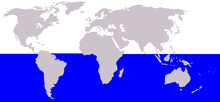Southern minke whale
| Antarctic minke whale | |
|---|---|
 |
|
| Antarctic minke whale in Ross Sea | |
 |
|
| Size compared to an average human | |
| Scientific classification | |
| Kingdom: | Animalia |
| Phylum: | Chordata |
| Class: | Mammalia |
| Order: | Artiodactyla |
| Infraorder: | Cetacea |
| Family: | Balaenopteridae |
| Genus: | Balaenoptera |
| Species: | B. bonaerensis |
| Binomial name | |
|
Balaenoptera bonaerensis Burmeister, 1867 |
|
 |
|
| Antarctic minke whale range | |
The Antarctic minke whale or southern minke whale (Balaenoptera bonaerensis) is a species of minke whale within the suborder of baleen whales. It is the second smallest rorqual after the common minke whale and the third smallest baleen whale. Although first scientifically described in the mid-19th century, it was not recognized as a distinct species until the 1990s. Once ignored by the whaling industry due to its small size and low oil yield, the Antarctic minke was able to avoid the fate of other baleen whales and maintained a large population into the 21st century, numbering in the hundreds of thousands. Surviving to become the most abundant baleen whale in the world, it is now one of the mainstays of the industry alongside its cosmopolitan counterpart the common minke. It is primarily restricted to the Southern Hemisphere (although vagrants have been reported in the North Atlantic) and feeds mainly on euphausiids.
In February 1867, a fisherman found an estimated 9.75 m (32.0 ft) male rorqual floating in the Río de la Plata near Belgrano, about ten miles from Buenos Aires, Argentina. After bringing it ashore he brought it to the attention of the German Argentine zoologist Hermann Burmeister, who described it as a new species, Balaenoptera bonaerensis, the same year. The skeleton of another specimen, a 4.7 m (15 ft) individual taken off Otago Head, South Island, New Zealand, in October 1873, was sent by Professor Frederick Wollaston Hutton, keeper of the Otago Museum in Dunedin, to the British Museum in London, where it was examined by the British zoologist John Edward Gray, who described it as a new species of "pike whale" (minke whale, B. acutorostrata) and named it B. huttoni. Both descriptions were largely ignored for a century.
...
Wikipedia

